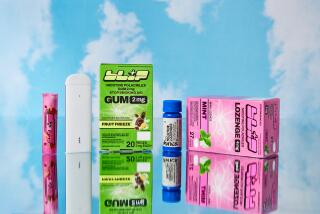Big Guilt Trip Is Packed Inside a Little Juice Box : * Environment: While eco-minded consumers fret over adding to the waste stream, producers contend the convenient packages are recyclable.
NEW YORK â Children love them. Parents canât imagine life without them. Theyâre convenient, nutritious, tasty and fun.
So why do people feel guilty about using juice packs?
âThose juice boxes are convenient,â said Mary Bussmann, a mother of two in Palo Alto, âbut the one issue I have with them is the environment. Itâs just one more thing to pitch.â
It is a classic â90s dilemma for eco-minded parents. No sooner do they finish struggling with the decision of whether to use convenient disposable diapers (bad!) or messy cloth diapers (good!), than their children are junking up the waste stream with those wonderful, handy and almost entirely non-recyclable drink boxes.
âI went to the grocery store last night,â Bussmann said, âand I thought, âDo I want these or do I want the apple juice in glass?â And I opted for the glass.â
Itâs tough for parents, but comments like that are downright scary for the people who make the little boxes, which have been called the most significant innovation in food science in the past half century.
So the manufacturers are fighting back.
The battle was joined last year when Maine banned the boxes. State officials said it made no sense to make people recycle glass and cans when they couldnât recycle drink boxes, known in the industry as aseptic packages.
Maineâs ban had national repercussions.
âThere was an immediate impact on the aseptic sales,â said Kim Nilsen, marketing manager for After the Fall, a fruit juice producer in Brattleboro, Vt.
After the Fall sells most of its juice boxes to natural foods stores, whose customers are especially sensitive to environmental issues. Nilsen said the drop in sales was âprecipitous.â
Since then, drink box manufacturers have launched pilot recycling programs in a dozen states to prove that the packs can be recycled. And theyâve launched a public relations campaign to convince people that drink boxes are more than recyclable--theyâre also energy efficient and promote good nutrition.
Juice boxes are a convenient shape for shipping. It takes fewer trucks to ship them because they take up less space than bottles or cans.
And aseptic packaging requires less heat--hence, less energy--than canning or bottling, industry officials say. And once packed in the airless, lightless, sterile packs, even milk can be shipped and stored for long periods without refrigeration.
âThe amount of energy saved by having that non-refrigerated distribution system is just amazing,â said Marshall Cohen, president of the Aseptic Packaging Council, an industry association.
Katherine Thompson, a nutrition professor at the University of New England, spoke of the nutritional benefits of aseptic packaging. Because the process uses quick flashes of heat to sterilize the beverages, it doesnât cook away as many nutrients as canning and bottling, she said.
âThere is more than an environmental issue here,â she said. âYou have to look at this package and all its attributes.â
But the environmental issue is crucial.
Two juice box manufacturers and their ad agency last month agreed to a settlement with 10 states prohibiting false claims that the popular containers are easy to recycle. The agreement requires the companies to pay a total of $75,000 to the states and also permits state officials to screen juice-box advertisements for questionable environmental claims.
The two companies, Tetra Pak Inc. and Combibloc Inc, and their ad agency, Lintas Inc., admitted no wrongdoing under the pact with the states.
âWeâre very committed to recycling,â Susan Levine, vice president for marketing of Combibloc Inc., said before the settlement. âWeâre planning to expand.â
So far, the Aseptic Packaging Council has mainly sponsored recycling in schools, since children are the biggest consumers of drink boxes and schools are relatively easy places to organize recycling programs.
The program has not been without controversy.
In Contra Costa County, across the bay from San Francisco, recycling specialist Sheila Cogan charged that a school recycling program sponsored by the Aseptic Packaging Council was only able to collect about 50 drink boxes a day--and could only recycle them with a huge infusion of industry money.
She said she was censured and then suspended for criticizing the program and for arguing that the Aseptic Packaging Council was using the county schools for its own gains.
What happens to recycled drink boxes? They are hydrapulped--churned up in a vat of water, essentially--until they can be broken down into their main ingredients, paperboard, polyethylene and aluminum. The paperboard is separated from the plastic and metal, and can be turned into paper. The other substances can be turned into a variety of less-than-essential products, including boat pier bumpers and signposts.
Industry officials say itâs not that costly, and the pulp it produces can fetch premium prices.
Ohio Pulp Mills in Cincinnati has successfully turned drink boxes into high-grade paper, company President Bob Mendelson said.
âThatâs the good news,â he said. âThe bad news is--thatâs not recycling. Thatâs repulping. Itâs only recycling when somebody buys that pulp.â
More to Read
Inside the business of entertainment
The Wide Shot brings you news, analysis and insights on everything from streaming wars to production â and what it all means for the future.
You may occasionally receive promotional content from the Los Angeles Times.








